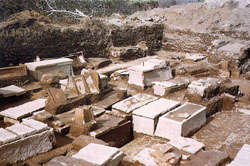
L. Bernab˛ Brea, M. Cavalier - Meligunìs Lipàra II
La necropoli greca e romana nella contrada Diana, con appendici di A.D. Trendall, T.B.L. Webster, e di M.T. Currò, Palermo 1965.
L. Bernabò Brea, M. Cavalier - Meligunìs Lipàra V
Scavi nella necropoli greca di Lipari, Roma 1991.
L. Bernabò Brea, M. Cavalier - Meligunìs Lipàra VII
Lipari
Contrada Diana. Scavo XXXVI in proprietà Zagami (l975-1993) Palermo,1995.
L. Bernab˛ Brea, M. Cavalier, F. Villard - Meligunìs Lipàra XI
Gli scavi nella necropoli greca e romana nell'area del Palazzo vescovile, in due volumi, Palermo 2001.
These four volumes dedicated to Aeolian archaeology describe the finds from the Greek and Roman necropolis of Lipari whose excavations, directed by the authors, continued from 1948 to 1993. Some 2500 grave assemblages, dating over a period of nine centuries, from the 6th century BC to the 3rd century AD, offer a comprehensive picture of the evolution of funerary rites, pottery forms, the styles of their decoration, the various types of figurative terracottas, bronze objects, gold jewellery and so on, over this long period.
In the field of pottery, imported wares from distant pottery-making centres in Greece itself, first Corinth in particular, later Athens (its pottery studied by Franšois Villard), were succeeded in the course of the 4th century BC by wares from kilns in Magna Graecia (the Greek colonies in southern Italy), Sicily and Lipari itself. The pottery from Magna Graecia comprises large kraters (wine-mixing bowls with pedestals and handles under the rim) painted with figural decoration, often presenting rare mythological scenes or episodes from so-called Phlyax plays, outstanding among which are those attributable to the hand of the leading potter from Paestum, Asteas.
In the second half of the 4th century BC this local pottery production continued. It reached the highest point of its development in the early 3rd century BC with the accomplished products of a master whose name is unknown, but who is conventionally called the "Lipari Painter" and his pupils. An unusually vivid polychromy is often preserved in all its freshness on the vases of these masters.
In the field of terracotta sculpture the discovery of a huge number of small figured terracottas with theatrical motifs: miniature theatrical masks, tragic and comic, statuettes of the dramatis personae of satyr plays, of ancient comedy and satire, and of masks of the New Comedy (exemplified by Menander). Their production stretched from the mid-4th century BC to the destruction of Lipari by the Romans in 252-251 BC.
These terracottas represent as a whole not only one of the largest and most complete, but also one of the earliest, of the series of surviving monuments relating to the history of the Greek theatre. The archaeological finds show signs of decadence in the last years of the life of the city. They also attest to its weak revival after 252 BC, very far from its ancient splendours, but corroborated by various funerary assemblages that continued down to the Roman imperial period.
